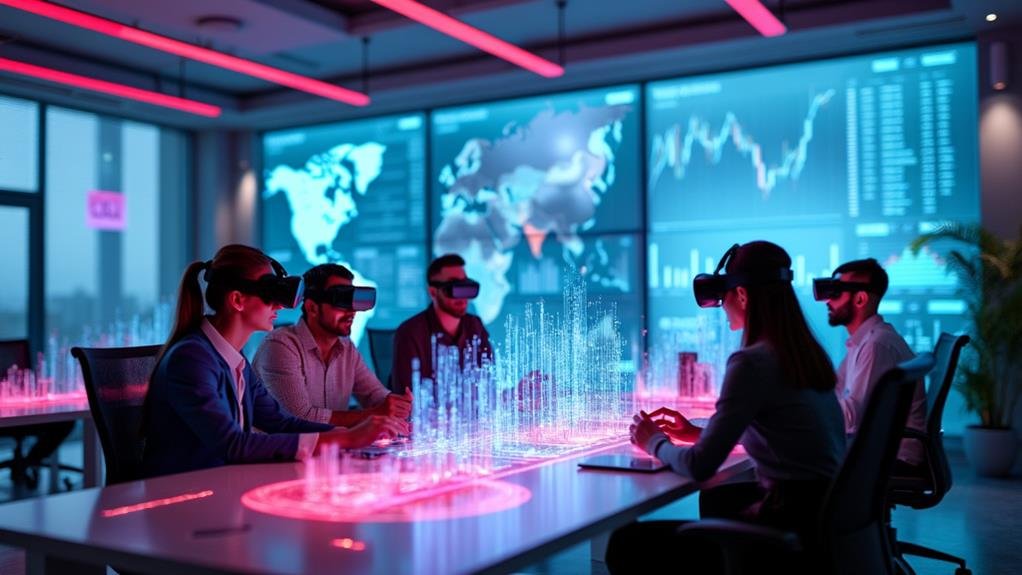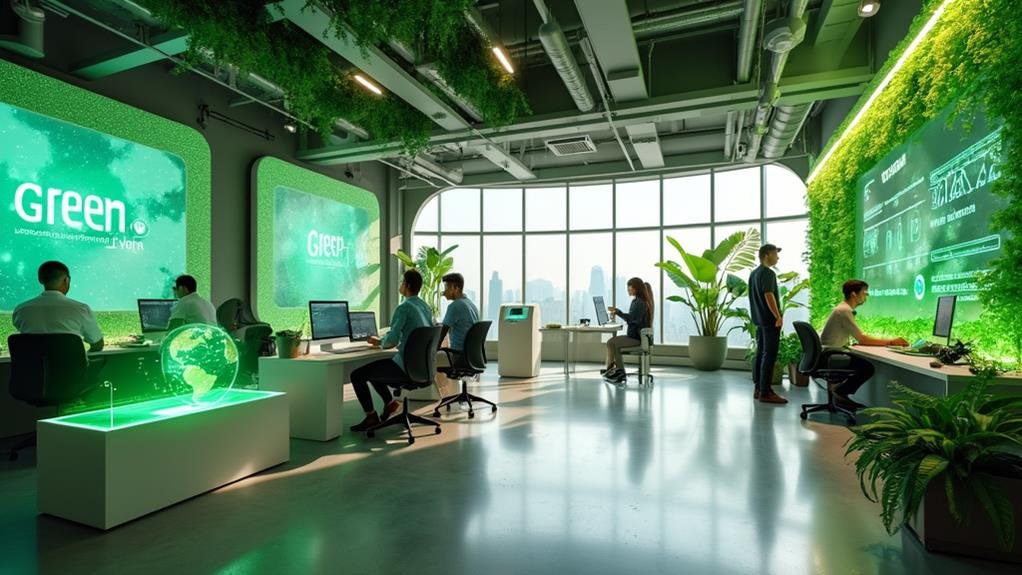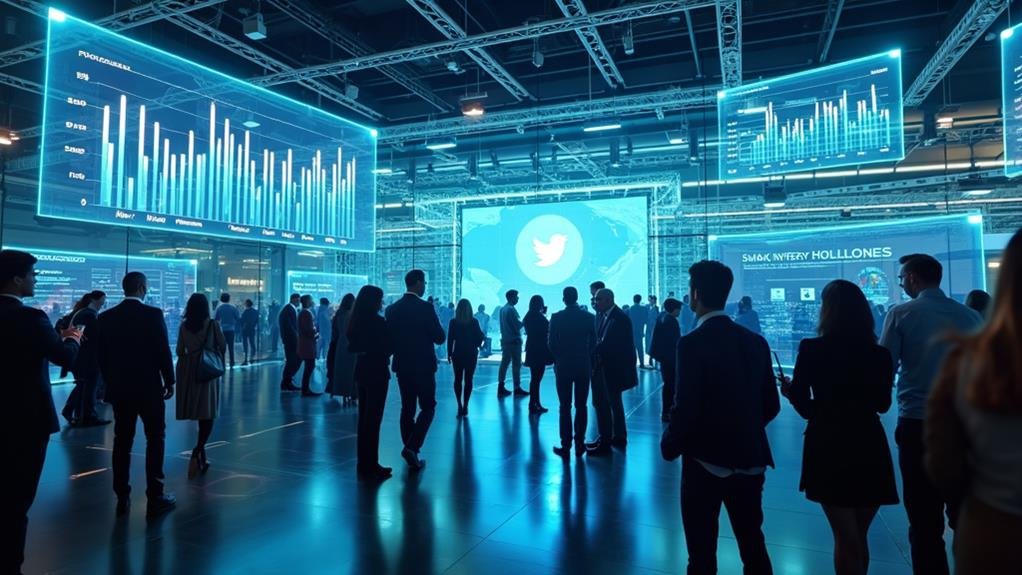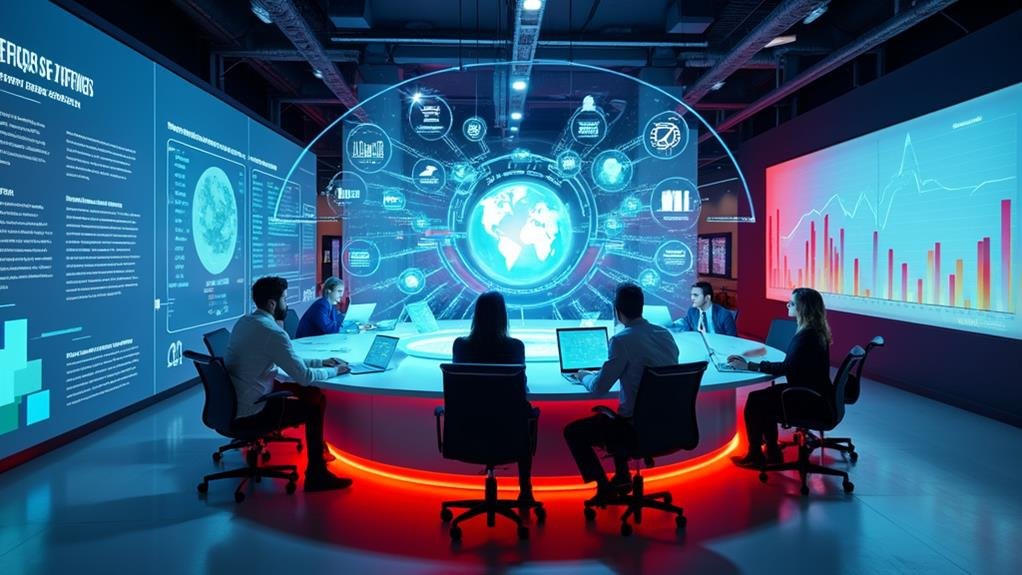We’ve identified 10 proven strategies for business sales and marketing success in 2025. These include data-driven decision making, AI-powered marketing automation, and personalized customer experiences. Video content dominance and voice search optimization are essential for engagement. Social commerce integration and influencer collaborations will drive sales, while agile marketing implementation guarantees adaptability. Augmented reality in sales offers immersive experiences, boosting conversion rates. Sustainability in marketing practices resonates with eco-conscious consumers, enhancing brand loyalty. By embracing these innovative approaches, businesses can expect up to a 20% increase in sales opportunities. Discover how these strategies can revolutionize your marketing efforts and propel your business forward.

As we approach 2025, data-driven decision making has become the cornerstone of successful business sales and marketing strategies.
We’ve seen firsthand how analyzing current performance and evaluating overall budget effectiveness can identify high-impact areas for investment. By leveraging customer data, we’re able to create personalized campaigns that greatly boost engagement and ROI. Remember that email marketing campaign that generated a 13x return? That’s the power of data-driven segmentation at work.
Setting measurable goals based on collected data isn’t just a good idea—it’s vital. We must track our performance to guarantee our marketing activities align with business objectives. This continuous analysis allows us to pinpoint our best lead sources and highest-value customers, refining our targeting for maximum effect.
We’re not just guessing anymore; we’re making informed decisions.
To stay ahead, we need to embrace multiple data collection methods. Surveys, social media analytics, and other tools provide essential insights into consumer behavior trends.

Three key innovations are revolutionizing marketing automation in 2025: AI-powered content creation, personalized campaign optimization, and real-time engagement analysis.
We’re seeing a dramatic shift in how businesses approach their marketing strategies, with AI at the forefront of this transformation. By leveraging AI tools, companies are now able to create high-quality content more efficiently than ever before, streamlining production processes and meeting the growing demand for engaging video content.
The impact of AI-driven marketing automation is indisputable. With personalized campaigns yielding up to a 13x ROI, it’s clear that tailoring content to specific audience segments is no longer just a luxury—it’s a necessity.
AI algorithms analyze vast amounts of customer data, enabling businesses to optimize their marketing strategies and drive a 20% increase in sales opportunities. Additionally, the ability to monitor engagement metrics in real time allows for agile adjustments to campaigns, ensuring maximum effectiveness.
As we move further into 2025, companies that embrace AI-powered marketing automation will certainly have a significant competitive advantage in the ever-evolving digital landscape.

Personalization has become the cornerstone of successful customer experiences in 2025.
We’re seeing a remarkable 20% increase in sales opportunities when we tailor our messaging to individual preferences and behaviors. It’s clear that consumers not only expect personalized content, they’re actively seeking it out.
By utilizing customer data for segmentation, we’re able to create targeted marketing campaigns that resonate more effectively with specific audience segments.
This approach is paying off big time, with 80% of consumers more likely to make a purchase when offered a personalized experience. We can’t ignore these numbers.
To streamline this process, we’re implementing AI tools that deliver relevant content and recommendations in real-time.
This isn’t just about boosting sales; it’s about fostering brand loyalty. A whopping 70% of consumers prefer brands that recognize and reward their individual preferences.
By focusing on personalization, we’re not only enhancing customer satisfaction but also building lasting relationships with our audience.
In today’s competitive market, this personalized approach isn’t just a nice-to-have – it’s a must-have for businesses looking to thrive in 2025 and beyond.

Video content has catapulted to the forefront of digital marketing strategies in 2025. We’re witnessing a seismic shift in consumer preferences, with an overwhelming 89% of people clamoring for more brand videos.
It’s clear: if we’re not leveraging video, we’re missing out on a massive opportunity to engage our audience.
Short-form videos are leading the charge. Platforms like TikTok and Facebook Reels have become goldmines for capturing attention and driving engagement.
We can’t afford to ignore these channels if we want to stay relevant. But it’s not just about being trendy; it’s about connecting authentically. That’s where live streaming comes in, offering us a real-time platform to interact with our audience and showcase our products.
We must also focus on creating educational content, product demos, and behind-the-scenes videos. These types of content build trust and loyalty, which are priceless in today’s market.
As we craft our video strategies, let’s not forget the importance of mobile optimization. With more people glued to their smartphones, ensuring our videos are mobile-friendly and quick to load is non-negotiable.

As we navigate the evolving landscape of digital marketing, voice search optimization has become a game-changer. With nearly half of consumers using voice for web searches, we can’t afford to ignore this trend. It’s time to adapt our SEO strategies to stay ahead of the curve.
We need to rethink our approach to content creation. Incorporating conversational language and long-tail keywords is no longer optional; it’s vital for boosting our visibility in voice search results.
Let’s focus on providing succinct answers to common queries, as voice searches often yield direct responses rather than links to websites. This shift demands a more targeted approach to content development.
Local SEO takes center stage in voice search optimization. As users frequently seek information about nearby services, we must prioritize our local presence.
Implementing structured data markup is another important step. It helps search engines better understand our website’s content, increasing our chances of appearing in voice search results.

Sustainability in marketing practices isn’t just a trend; it’s become a necessity for businesses aiming to thrive in 2025 and beyond. We’re seeing a significant shift in consumer behavior, with 66% of customers willing to pay more for sustainable brands. This presents a golden opportunity for companies to align their marketing strategies with eco-friendly initiatives.
Let’s break down the key benefits of sustainable marketing:
| Benefit | Impact | Statistic |
|---|---|---|
| Consumer Loyalty | Increased | 20% boost |
| Brand Credibility | Enhanced | 81% trust |
| Competitive Edge | Improved | 72% preference |
By adopting sustainable practices, we’re not only doing right by the environment but also bolstering our bottom line. Content marketing focused on transparency about our eco-friendly efforts can dramatically enhance our brand’s reputation. Additionally, we’ll see a substantial reduction in marketing costs—up to 30%—by embracing digital platforms and reducing paper usage.
It’s clear: sustainability isn’t just good for the planet; it’s good for business. As we move towards 2025, integrating these practices into our marketing strategies isn’t optional—it’s imperative for long-term success and consumer engagement.

While sustainability shapes our marketing practices, another force is revolutionizing how we connect with consumers: social commerce.
We’re witnessing a seismic shift in the e-commerce landscape, with social commerce projected to reach a staggering $1.2 trillion in sales by 2025. This isn’t just a trend; it’s a fundamental change in how consumers shop and interact with brands.
Consider this: over half of social media users now turn to these platforms for product research before making a purchase. We can’t afford to ignore this opportunity.
By integrating e-commerce features like shoppable posts and live shopping events, we’re not just meeting customers where they are; we’re creating engaging experiences that drive sales. The numbers don’t lie – brands effectively leveraging social commerce are seeing up to 20% increases in conversion rates.
But it’s not just about selling; it’s about building trust. User-generated content on social media is trusted by nearly 80% of consumers.
We must harness this power, encouraging and showcasing authentic customer experiences to establish credibility. In doing so, we’re not just adapting to the future of commerce; we’re shaping it.

How can we harness the power of influencers to drive our brand’s success in 2025? With influencer marketing projected to reach $16.4 billion in 2022, it’s clear that this strategy isn’t just a passing trend.
We need to focus on collaborating with micro-influencers, those with 1,000 to 100,000 followers. Why? Because they deliver higher engagement rates, often exceeding 60% compared to their larger counterparts.
Let’s face it, consumers trust user-generated content more than traditional promotional messages. By leveraging authentic influencer-created content, we’re tapping into that trust.
Over 90% of marketers have found influencer collaborations effective in driving brand awareness, with 86% reporting successful sales generation. That’s a powerful indication of the strategy’s effectiveness.
But here’s the kicker: brands see an average ROI of $5.78 for every dollar spent on influencer marketing. It’s not just about visibility; it’s about financial viability.
As we plan for 2025, we must strategically integrate influencer collaborations into our marketing mix, focusing on authenticity, engagement, and measurable results.

As we approach 2025, agile marketing implementation will be vital for staying ahead in the rapidly evolving business landscape. We must embrace continuous evaluation and adjustment of our strategies based on real-time data and market shifts. This approach allows us to maintain responsiveness to emerging trends and customer preferences.
By adopting agile methodologies, we’ll foster a culture of experimentation within our organizations. We’ll be able to test new approaches and quickly pivot when certain tactics prove ineffective. Significantly, we’ll utilize feedback loops to refine our practices and guarantee alignment with customer needs.
Regular progress assessments against set goals will help us maintain focus and drive results, assuring our marketing efforts contribute effectively to overall business growth.
Agile marketing encourages cross-functional collaboration, enabling our teams to share insights and adapt strategies rapidly. This collaborative approach optimizes our impact on sales and customer engagement.
As we implement these agile practices, we’ll find ourselves better equipped to navigate the dynamic marketing landscape of 2025 and beyond. The key lies in remaining flexible, data-driven, and customer-focused in all our marketing endeavors.

Revolutionizing the sales landscape, augmented reality (AR) is set to transform how businesses engage with customers in 2025.
We’re witnessing a seismic shift in consumer preferences, with 61% of shoppers now favoring retailers offering AR experiences. This isn’t just a passing trend; it’s a game-changer that’s projected to generate $198 billion in revenue by 2025.
Let’s face it: AR isn’t just about flashy tech. It’s a powerful tool that’s reshaping the customer journey. Brands leveraging AR are seeing impressive results, with a 40% boost in engagement and a 30% increase in conversion rates.
Why? Because AR empowers consumers. It allows them to visualize products in their own space, making purchasing decisions more informed and confident.
We can’t ignore the social media factor either. With 83% of consumers more likely to shop with brands offering AR on social platforms, it’s clear that integrating this technology into our marketing strategies isn’t optional—it’s essential.
As we look towards 2025, businesses that embrace AR won’t just survive; they’ll thrive in an increasingly competitive digital marketplace.
We’ve explored cutting-edge strategies that’ll reshape business sales and marketing in 2025. By embracing these approaches, we’ll stay ahead of the curve and drive success. Consider how Nike used AI-powered chatbots to increase online sales by 30% through personalized recommendations. It’s clear that adaptability and innovation are key. As we move forward, let’s implement these strategies with confidence, always keeping our customers’ evolving needs at the forefront. The future of sales and marketing is dynamic, and we’re ready to lead the charge.